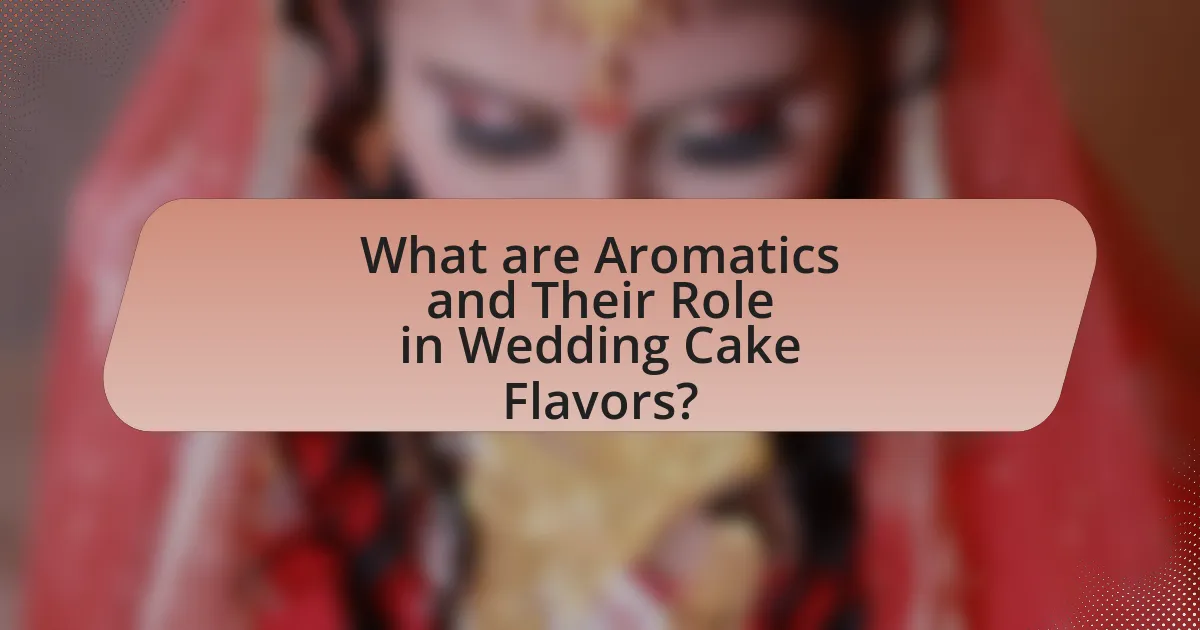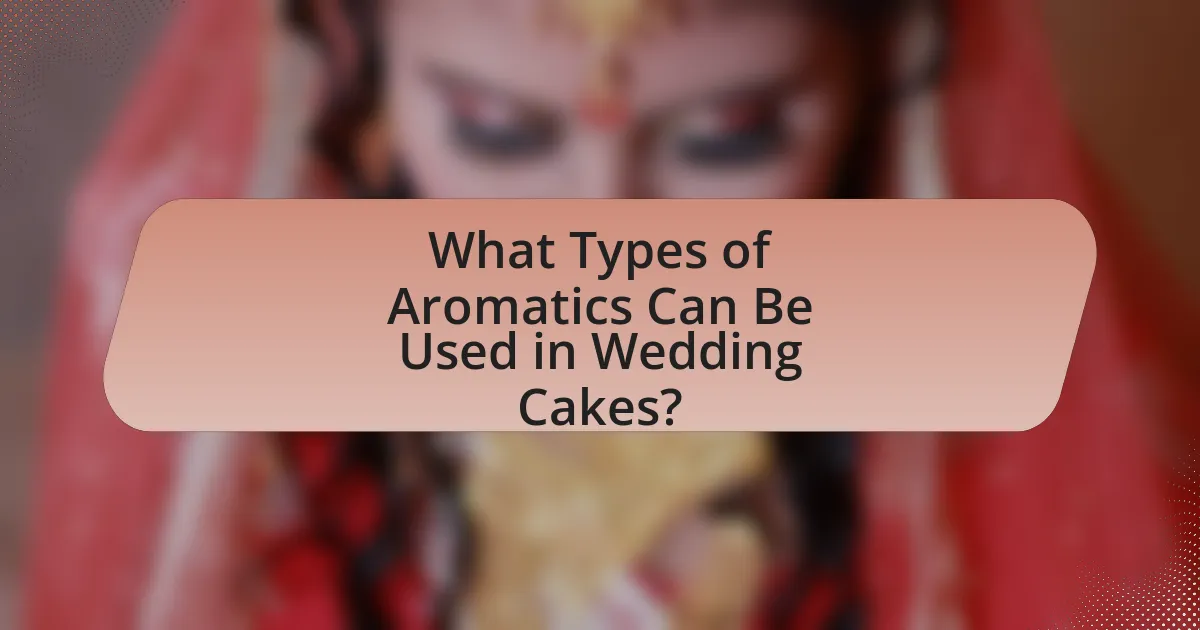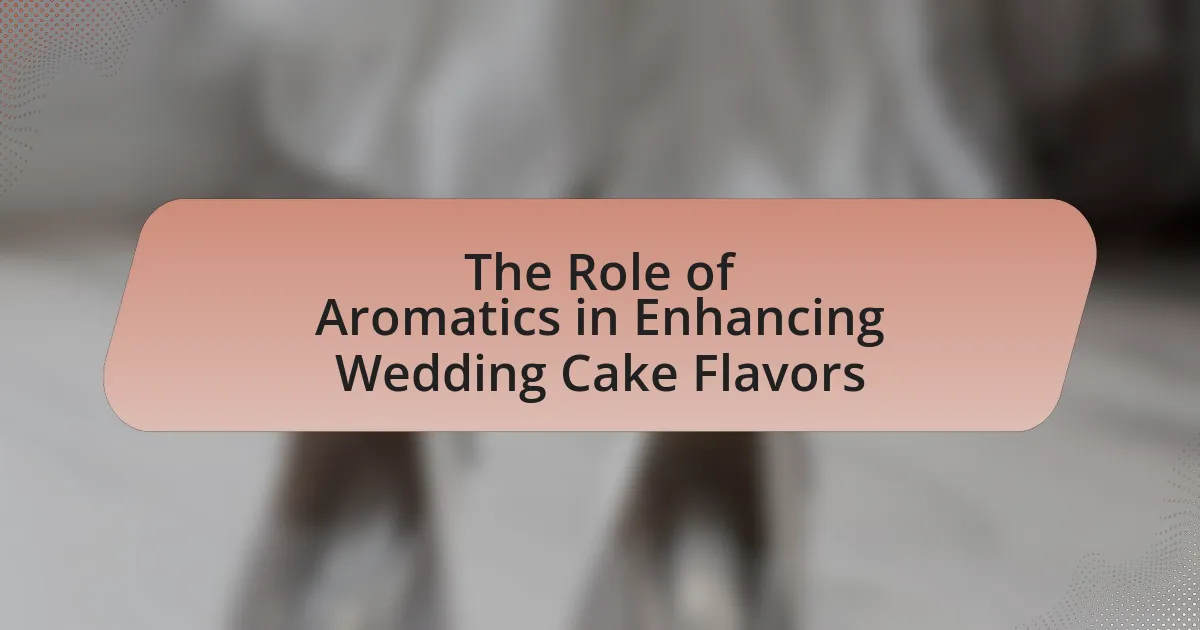Aromatics play a crucial role in enhancing the flavors of wedding cakes, significantly influencing both taste and aroma. This article explores the various types of aromatics commonly used, such as vanilla, citrus zest, and floral extracts, and their impact on the overall flavor profile. It discusses how these compounds interact with cake ingredients to create a balanced and memorable sensory experience, as well as the emotional significance they carry during weddings. Additionally, the article addresses best practices for incorporating aromatics effectively, potential pitfalls to avoid, and the differences between natural and artificial aromatics in flavor intensity.

What are Aromatics and Their Role in Wedding Cake Flavors?
Aromatics are compounds that contribute to the fragrance and flavor profile of food, including wedding cakes. In wedding cake flavors, aromatics enhance the overall sensory experience by adding depth and complexity, often derived from natural sources such as vanilla, citrus zest, or spices. For instance, vanilla extract is a common aromatic that provides a sweet, creamy note, while citrus zest can introduce a refreshing brightness. The use of these aromatics not only elevates the taste but also creates a memorable olfactory experience, which is crucial for special occasions like weddings. Studies have shown that flavor perception is significantly influenced by aroma, underscoring the importance of aromatics in creating a well-rounded wedding cake flavor profile.
How do aromatics influence the overall flavor profile of wedding cakes?
Aromatics significantly influence the overall flavor profile of wedding cakes by enhancing and complementing the primary flavors present in the cake. These aromatic compounds, which can include vanilla, citrus zest, almond extract, and spices, contribute to the complexity and depth of flavor, making the cake more appealing to the palate. For instance, vanilla is a common aromatic that adds sweetness and warmth, while citrus zest can introduce brightness and freshness, balancing richer flavors. Studies in flavor chemistry indicate that the presence of these aromatics can elevate the sensory experience, as they interact with taste receptors and enhance the perception of sweetness and richness in baked goods.
What specific aromatics are commonly used in wedding cakes?
Common aromatics used in wedding cakes include vanilla, almond, lemon, and orange zest. Vanilla is the most prevalent aromatic, known for its sweet and creamy flavor profile, which enhances the overall taste of the cake. Almond extract adds a nutty depth, while lemon and orange zest contribute a refreshing citrus note that balances sweetness. These aromatics are frequently chosen for their ability to complement various cake flavors and fillings, making them staples in wedding cake recipes.
How do different aromatics interact with cake ingredients?
Different aromatics interact with cake ingredients by enhancing flavor profiles and contributing to the overall sensory experience. For instance, vanilla extract complements sweet ingredients like sugar and butter, creating a harmonious balance that elevates the cake’s taste. Citrus zest, such as lemon or orange, adds brightness and acidity, which can counteract the richness of fats, resulting in a more complex flavor. Spices like cinnamon and nutmeg introduce warmth and depth, interacting with the cake’s sweetness to create a layered flavor experience. Additionally, floral aromatics, such as lavender or rose, can impart subtle notes that enhance the cake’s aroma and flavor, making it more appealing. These interactions are supported by culinary principles that emphasize the importance of balance and contrast in flavor development.
Why are aromatics important in creating memorable wedding cake experiences?
Aromatics are crucial in creating memorable wedding cake experiences because they enhance flavor perception and evoke emotional responses. The sense of smell significantly influences taste; studies show that up to 80% of flavor is derived from aroma. For instance, specific aromatic compounds in vanilla or citrus can trigger nostalgia and joy, making the cake more enjoyable. Additionally, the unique scent of a wedding cake can create lasting memories associated with the event, reinforcing the emotional significance of the occasion.
What sensory experiences do aromatics enhance in wedding cakes?
Aromatics enhance the sensory experiences of taste and smell in wedding cakes. The incorporation of ingredients such as vanilla, citrus zest, or floral extracts not only elevates the flavor profile but also creates a fragrant aroma that engages the olfactory senses. Research indicates that the combination of taste and smell significantly influences overall flavor perception, with studies showing that aroma can account for up to 80% of what we perceive as flavor. This interplay between aromatics and the cake’s ingredients results in a more memorable and enjoyable eating experience, making the wedding cake a focal point of sensory delight during celebrations.
How do aromatics contribute to the emotional impact of wedding cakes?
Aromatics significantly enhance the emotional impact of wedding cakes by evoking memories and creating a sensory experience that resonates with the couple and their guests. The specific scents associated with various cake flavors, such as vanilla, almond, or citrus, can trigger emotional responses linked to personal experiences or cultural traditions. Research indicates that scent is closely tied to memory; for instance, a study published in the journal “Chemical Senses” highlights how olfactory stimuli can elicit vivid recollections and feelings, reinforcing the emotional significance of the wedding celebration. Thus, the aromatic qualities of wedding cakes not only contribute to their flavor but also play a crucial role in shaping the overall emotional atmosphere of the event.

What Types of Aromatics Can Be Used in Wedding Cakes?
Various types of aromatics can be used in wedding cakes, including vanilla, almond, citrus zest, and floral extracts. Vanilla is the most common aromatic, known for its rich and sweet flavor profile that complements many cake types. Almond extract adds a nutty depth, while citrus zest, such as lemon or orange, provides a refreshing brightness. Floral extracts like rose or lavender introduce unique and sophisticated notes, enhancing the overall flavor experience. These aromatics not only contribute to the taste but also elevate the sensory appeal of wedding cakes, making them memorable for the occasion.
What are the most popular natural aromatics for wedding cakes?
The most popular natural aromatics for wedding cakes include vanilla, almond, lemon, and orange zest. Vanilla is widely favored for its rich and sweet flavor profile, often derived from vanilla beans or extracts. Almond extract adds a distinct nutty aroma that complements various cake flavors. Lemon and orange zest provide a refreshing citrus note, enhancing the overall taste experience. These aromatics are commonly used in wedding cake recipes to elevate flavor and create a memorable dessert.
How do citrus aromatics affect the flavor of wedding cakes?
Citrus aromatics significantly enhance the flavor of wedding cakes by adding brightness and complexity. The presence of citrus notes, such as lemon or orange, can balance sweetness and provide a refreshing contrast to richer ingredients like butter and cream. Studies have shown that citrus flavors can stimulate the palate, making the overall tasting experience more enjoyable. For instance, the use of lemon zest in cake recipes not only contributes to flavor but also adds aromatic compounds that elevate the cake’s scent, further enhancing the perception of taste.
What role do floral aromatics play in wedding cake recipes?
Floral aromatics enhance wedding cake recipes by adding complex flavors and aromas that elevate the overall sensory experience. These aromatics, such as lavender, rose, and orange blossom, contribute unique taste profiles that can complement traditional cake flavors like vanilla or almond. For instance, lavender provides a subtle earthiness, while rose adds a sweet, fragrant note. The incorporation of these floral elements not only enriches the cake’s flavor but also creates a memorable and elegant presentation, aligning with the celebratory nature of weddings.
How can artificial aromatics be incorporated into wedding cake flavors?
Artificial aromatics can be incorporated into wedding cake flavors by using concentrated flavor extracts, emulsions, or flavoring oils that mimic natural scents and tastes. These products can be added directly to the cake batter, frosting, or fillings to enhance the overall flavor profile. For instance, vanilla, almond, or citrus flavor extracts can provide a strong aromatic presence, while flavoring oils can offer more intense and varied notes. The use of these artificial aromatics allows bakers to achieve consistent flavor results and cater to specific preferences, ensuring that the wedding cake meets the desired taste and aroma expectations.
What are the advantages and disadvantages of using artificial aromatics?
The advantages of using artificial aromatics include cost-effectiveness, consistency in flavor, and a longer shelf life compared to natural aromatics. Artificial aromatics can be produced at a lower cost, making them accessible for large-scale production, and they provide uniform flavor profiles that are essential for maintaining quality in wedding cakes. However, the disadvantages involve potential health concerns, as some artificial aromatics may contain synthetic compounds that could cause allergic reactions or other health issues. Additionally, the flavor complexity of artificial aromatics often lacks the depth and richness found in natural alternatives, which can affect the overall taste experience of the wedding cake.
How do artificial aromatics compare to natural ones in flavor intensity?
Artificial aromatics generally exhibit greater flavor intensity compared to natural ones. This is due to the concentrated nature of synthetic compounds, which can be engineered to enhance specific flavor profiles more effectively than their natural counterparts. For instance, studies have shown that artificial flavorings can achieve higher potency levels, often requiring smaller quantities to achieve the desired taste impact, as seen in food science research published in the Journal of Agricultural and Food Chemistry.

How Can Bakers Effectively Use Aromatics in Wedding Cakes?
Bakers can effectively use aromatics in wedding cakes by incorporating natural extracts, herbs, and spices to enhance flavor profiles. For instance, vanilla extract is a common aromatic that adds depth, while citrus zest can brighten the overall taste. Additionally, using fresh herbs like rosemary or lavender can introduce unique flavor notes that resonate with the couple’s preferences. Studies show that the aroma of baked goods significantly influences taste perception, making the strategic use of aromatics essential for creating memorable wedding cakes.
What techniques can bakers use to enhance flavors with aromatics?
Bakers can enhance flavors with aromatics by incorporating techniques such as infusing, macerating, and using extracts. Infusing involves steeping herbs, spices, or citrus peels in liquids like milk or cream to extract their flavors, which can then be incorporated into batters or frostings. Macerating fruits with sugar allows the release of their natural juices and essential oils, intensifying their flavor profile for fillings or toppings. Additionally, using high-quality extracts, such as vanilla or almond, can provide concentrated flavor enhancements that elevate the overall taste of the cake. These methods are supported by culinary practices that emphasize the importance of aromatics in flavor development, ensuring a more complex and enjoyable tasting experience.
How can aromatics be infused into cake batters and frostings?
Aromatics can be infused into cake batters and frostings by incorporating concentrated flavor extracts, essential oils, or fresh herbs and spices during the mixing process. For instance, adding vanilla extract or almond extract directly into the batter enhances the overall flavor profile. Essential oils, such as lemon or orange, can be used sparingly to impart a strong aromatic quality. Fresh herbs like basil or mint can be finely chopped and mixed into the batter or frosting for a unique flavor twist. The infusion of these aromatics not only enhances the taste but also contributes to the overall sensory experience of the cake, making it more appealing.
What are the best practices for balancing aromatics in wedding cakes?
The best practices for balancing aromatics in wedding cakes include using complementary flavors, controlling the intensity of aromatic ingredients, and ensuring even distribution throughout the batter. Complementary flavors, such as pairing vanilla with citrus or almond, enhance the overall taste profile without overpowering the cake. Controlling the intensity involves using extracts or essences in moderation, as they can be more potent than whole ingredients. Even distribution ensures that each slice of cake has a consistent flavor experience, which can be achieved by thoroughly mixing the batter and incorporating aromatics at the right stage of preparation. These practices are supported by culinary principles that emphasize flavor harmony and balance in baking.
What common mistakes should bakers avoid when using aromatics?
Bakers should avoid overusing aromatics, as excessive amounts can overwhelm the cake’s flavor profile. Using too much of an aromatic can lead to an unbalanced taste, masking the subtleties of other ingredients. Additionally, bakers often make the mistake of not considering the potency of different aromatics; for instance, essential oils are much stronger than extracts and should be used in smaller quantities. Another common error is neglecting to incorporate aromatics at the right stage of the baking process, which can affect their flavor release and overall impact. Properly measuring and timing the addition of aromatics ensures that their flavors are enhanced rather than diminished.
How can overuse of aromatics negatively impact wedding cake flavors?
Overuse of aromatics can lead to overpowering flavors in wedding cakes, making them unbalanced and unpleasant. When aromatics such as vanilla, almond, or citrus are excessively used, they can dominate the palate, masking the cake’s natural sweetness and texture. This imbalance can result in a cake that is either too fragrant or harsh, detracting from the overall enjoyment. Studies in flavor chemistry indicate that the human palate can only perceive a limited range of flavors simultaneously; thus, overwhelming it with strong aromatics can lead to a negative tasting experience.
What are the signs of poorly balanced aromatic flavors in cakes?
Signs of poorly balanced aromatic flavors in cakes include an overpowering scent of one ingredient, such as vanilla or almond, which can overshadow other flavors. Additionally, a lack of complexity in aroma, where the cake smells flat or one-dimensional, indicates imbalance. Furthermore, an unpleasant or off-putting aroma, often resulting from the use of stale or low-quality ingredients, signifies poor flavor balance. Lastly, if the cake’s aroma does not align with its taste, this discrepancy suggests that the aromatic components are not well integrated, leading to a disjointed flavor experience.
What tips can help bakers create the perfect aromatic wedding cake?
To create the perfect aromatic wedding cake, bakers should focus on using high-quality ingredients, incorporating natural flavor extracts, and balancing flavors effectively. High-quality ingredients, such as fresh vanilla beans or premium cocoa powder, enhance the cake’s aroma and overall taste. Natural flavor extracts, like almond or citrus, can be added in moderation to create depth without overpowering the primary flavor. Additionally, balancing flavors by combining sweet, savory, and acidic notes can elevate the aromatic profile, making the cake more appealing. For instance, a hint of lemon zest can brighten a rich chocolate cake, while a touch of sea salt can enhance sweetness.
